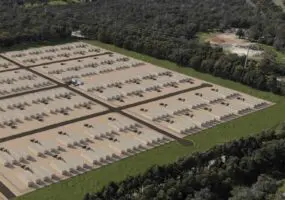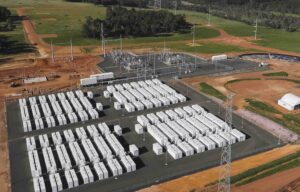AGL Energy has proposed to build a huge 100MW/150MWh battery next to the big 453MW Cooper’s Gap wind farm in Queensland, and has submitted the idea to the Coalition’s controversial underwriting mechanism for “24/7” power.
The proposal is revealed by AGL chief executive Brett Redman in an interview with RenewEconomy’s Energy Insiders podcast, and would be added to the newly opened Dalrymple North battery in South Australia it now operates, and a proposed battery near Liddell to help replace capacity when AGL closes that ageing coal plant in 2022.
The Queensland battery, however, would be the biggest in the country, with its storage capacity greater than the Tesla big battery next to the Hornsdale wind farm in South Australia (100MW/129MWh), although there are several other proposals that would also beat the Hornsdale facility, currently the world’s biggest.
There is some irony in AGL’s battery proposal, given that the Coalition is seeking to exclude the country’s biggest utilities from the process, and appears determined to funnel money to projects based around new investment in coal.
Most of the 66 proposals outlined to the government were centred around gas, and some – like Sanjeev Gupta’s proposal for large scale solar with battery and pumped hydro storage to power the Whyalla Steelworks and AGL’s newly revealed proposal – are based around renewables and storage.
But at least 10 of the proposals submitted to energy minister Angus Taylor are based around coal.
And the suspicion that this is the technology favoured by the Coalition was underlined when it pulled its so called “big stick” legislation after the Greens proposed an amendment, likely to be passed in the lower House, that would ban the Coalition from funding emissions-intensive generators such as coal.
The dumping of the big-stick bill, which may have forced the likes of AGL to sell its Liddell coal generator to a competitor rather than close it, appears designed to allow Taylor to keep his coal options open.
AGL is the biggest coal generator in the country, but it’s preferred new investment is in battery storage paired with renewables. It also recently unveiled a plan for a pumped hydro facility just north of its NSW coal generators.
Redman told the Energy Insiders podcast that there is no doubt that clean energy is now the cheapest.
“The last decade has seen a debate about clean versus cheap power. Clean is now the cheapest. The debate now becomes one of cheap versus reliable. When you build new, the cheapest is firmed renewables – with gas now and storage later.”
AGL is building a new 200MW fast-start gas generator in South Australia, mostly one as a substitute to its ageing Torrens gas units, and also to enable it to respond to the new 5-minute settlement periods that will be introduced in 2021.
The battery in Queensland would be paired with Cooper’s Gap, which will be by far the biggest wind farm in the Sunshine state that has seen mostly investment in solar farms over the past two years.
Redman says the AGL team studied the criteria of the tender process (which remains vague and has yet to be finalised). “We think this (battery proposal) meets the criteria. We put in a submission and we’ll see what happens.”
In a wide-ranging interview, Redman says the company is looking to upgrade its battery storage offering to homes, and will also “lean into” providing solar panels and batteries for big customers.”
AGL – like other big generators – is currently making bag-fulls of money from the current high prices in Australia’s wholesale electricity market. The challenge, Redman admits, is guiding the company to a future that will look a lot different, will be renewables based, and distributed rather than centralised.
“What I’m thinking about is not how we trade day to day – but how do we steer AGL through this grand transition,” Redman says.
“If we only focus on this year’s profit, and not on the next 100 years, we are not going to last … and many of the thing that we don’t want done to us will happen to us if we don’t have a social licence.”
Redman says reaching a majority of renewable energy across the country is not a matter of if, but when. “Once you get beyond 40 per cent (share of renewables) it is the time shifting and firming of renewbles that is the issue, not building it.”










